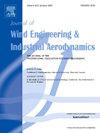The peak factor of dynamic wind loads on double-span conductors: insights from aeroelastic model tests
IF 4.9
2区 工程技术
Q1 ENGINEERING, CIVIL
Journal of Wind Engineering and Industrial Aerodynamics
Pub Date : 2025-10-09
DOI:10.1016/j.jweia.2025.106251
引用次数: 0
Abstract
Dynamic wind loads on transmission line conductors are critical for designing power transmission systems subjected to strong winds. In practice, quasi-static theory is applied to compute these dynamic loads, using a peak factor defined as the ratio of mean extreme response to response standard deviation. This factor quantifies the maximum structural responses caused by dynamic wind forces. Current engineering standards typically derive the peak factor for conductors from the Gaussian assumption, a premise that lacks rigorous validation, and its prescribed value varies significantly across wind load codes and standards. To address this gap, this paper develops an aeroelastic model of double-span, single-column conductors and conducts wind tunnel tests to assess the validity of existing assumptions and determine the peak factor under strong wind conditions. Furthermore, experiments on double-span, multi-column conductors are performed to examine the influence of aerodynamic shading and asynchronous pulsations between adjacent conductors on both the peak factor and wind load distribution. Findings provide experimental validation of Gaussian-based peak factor derivation for dynamic wind loads on conductors, yielding a measured peak factor of approximately 3.6. While interaction effects between conductors have negligible impacts on the peak factor and mean wind loads, they significantly reduce dynamic wind loads.
双跨导线动风荷载峰值因子:来自气动弹性模型试验的见解
输电线路导线上的动态风荷载对于设计强风作用下的输电系统至关重要。在实际应用中,准静态理论被应用于计算这些动态载荷,使用峰值因子定义为平均极端响应与响应标准差的比值。该系数量化了由动态风力引起的最大结构响应。目前的工程标准通常从高斯假设中得出导线的峰值系数,这是一个缺乏严格验证的前提,其规定的值在不同的风荷载规范和标准中变化很大。为了解决这一差距,本文开发了双跨单柱导体的气动弹性模型,并进行了风洞试验,以评估现有假设的有效性,并确定强风条件下的峰值因子。此外,还对双跨、多柱导线进行了试验,研究了相邻导线间的气动遮阳和异步脉动对峰值因子和风荷载分布的影响。研究结果为导体上动态风荷载的基于高斯的峰值因子推导提供了实验验证,得到了约3.6的实测峰值因子。导线间的相互作用对峰值因子和平均风荷载的影响可以忽略不计,但对动风荷载有显著的降低作用。
本文章由计算机程序翻译,如有差异,请以英文原文为准。
求助全文
约1分钟内获得全文
求助全文
来源期刊
CiteScore
8.90
自引率
22.90%
发文量
306
审稿时长
4.4 months
期刊介绍:
The objective of the journal is to provide a means for the publication and interchange of information, on an international basis, on all those aspects of wind engineering that are included in the activities of the International Association for Wind Engineering http://www.iawe.org/. These are: social and economic impact of wind effects; wind characteristics and structure, local wind environments, wind loads and structural response, diffusion, pollutant dispersion and matter transport, wind effects on building heat loss and ventilation, wind effects on transport systems, aerodynamic aspects of wind energy generation, and codification of wind effects.
Papers on these subjects describing full-scale measurements, wind-tunnel simulation studies, computational or theoretical methods are published, as well as papers dealing with the development of techniques and apparatus for wind engineering experiments.

 求助内容:
求助内容: 应助结果提醒方式:
应助结果提醒方式:


